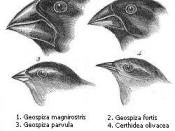IntroductionFlight is considered to many as a specialized and rare form of locomotion. Flight is defined by the Oxford English Dictionary as "the action or manner of flying or moving through the air with or as with wings." (Dudley 2000) In order to keep this paper simple, flight will be simply confined to the organisms that can truly fly while other "primitive" forms of flight such as gliding or parachuting will be disregarded. Only three general groups of organisms compose the population capable of flight; bats, most birds, and insects . Insects are the only invertebrate capable of true flight. The numbers of organisms that are capable of flight have been greatly limited by the mechanisms of evolution.
The definition of evolution is the process by which species of organisms arise from earlier life forms and undergo change over time through natural selection (Sommer 2002). Evolution is seen as having two main mechanisms that allow for changes to occur.
The first mechanism being the concept of genetic changing or adaptation and the second is natural selection. The number of flying species is limited by the first mechanism due to the low probability that an organism will evolve and fulfil the physiological requirements for flight (Dudley 2000). The second mechanism limits flight because, due to the limitation of food sources, organisms must become incredibly specialised and adapt to a specific niche.
Genetic ChangingOrganisms with the ability to fly are greatly reduced due to infrequency in the evolution of flight. It is though that there has only been four different time periods in which flying organism were introduced (Dudley 2000). The first being insects and the last being bats. These traits for flying were introduced by a species or a group of species. These organisms were exposed to an external factor that...


